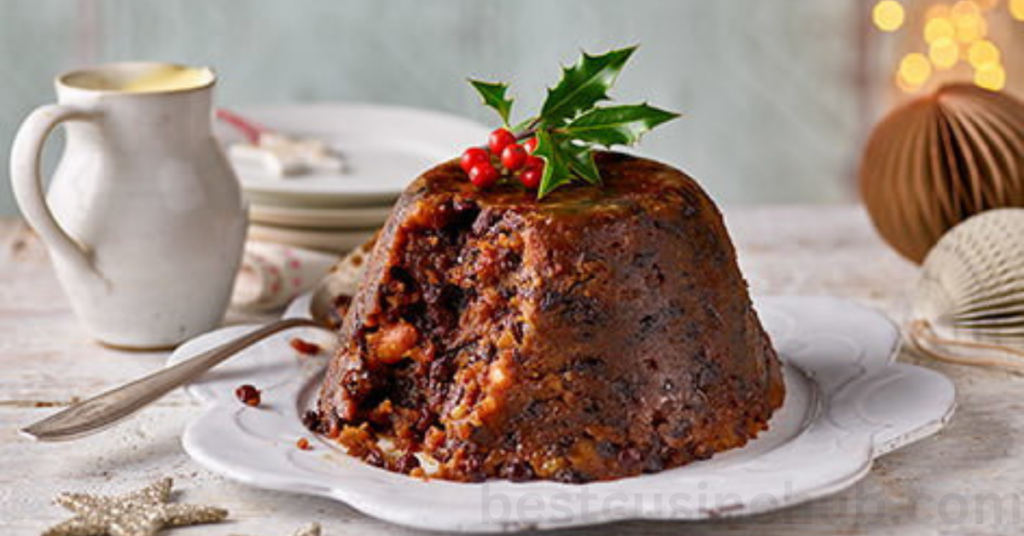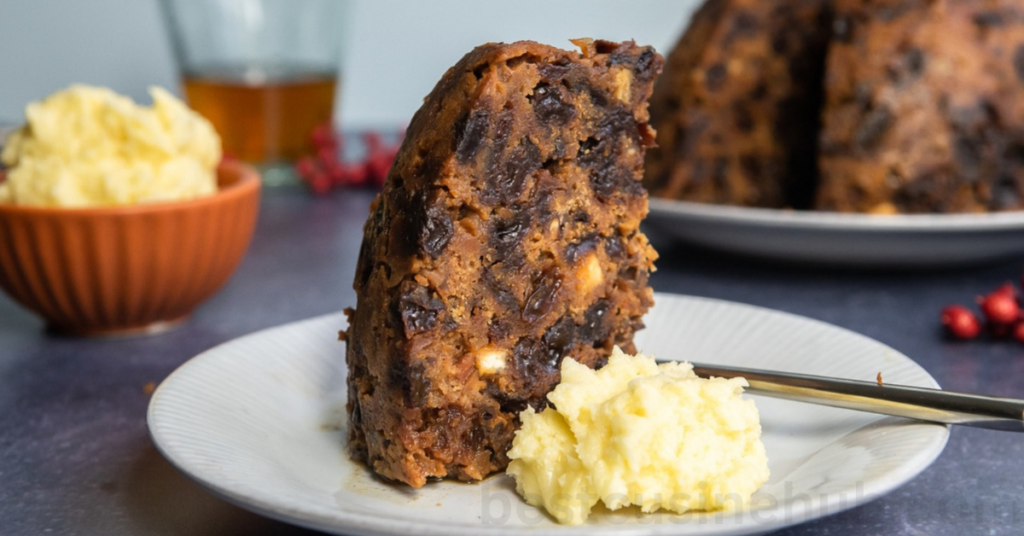Pudding particularly at Christmas is one sweet that is a Christmas favorite that is hard to let go of easily. It is a type of food that is associated with the love sentiments of the Christmas holiday. Moreover in this article we will present to you the historical roots of Christmas pudding, what it is made of and how you can prepare this delicious treat on your own. Whether for yourself, your family or for guests, this guide will help those who know their way around a kitchen as well as those who don’t, create a pudding that will be a tradition carried proudly through the years.
What Is Christmas Pudding?
Christmas pudding is another global name familiar as ‘plum pudding or figgy pudding,’ which forms part of the ceremonial Christmas feast menu. Contrary to what you might expect, it doesn’t include a thick, creamy pudding but rather a steamed or boiled fruit cake made with suet, flour, sugar, spice, and dried fruits, raisins, currants, sultanas. Everyone loves it with brandy butter, custards, or cream.
The consistency is heavy and juicy and the taste is piquant, is sugary. It’s often served with style—sometimes even lit with brandy and served table side, which definitely elevates the ambiance of your holiday dinner.

The History of Christmas Pudding
The dessert that is now referred to as Christmas pudding has its origins in medieval England. At first, it is completely different from what people consume today – a sweet fruit treat. Originally, Christmas pudding was a savory dish containing meat, grains, and spices, being prepared in the 14th century. The final shift in the recipe came only in the 17th century – instead of a savory preparation, children received something sweet, containing dried fruits, sugar, and alcohol.
Main Components in Christmas Pudding
Christmas pudding is richly flavored, and has a dense texture due to the solid food that is used in preparing it. Here are the essential ingredients you’ll need:
Dried Fruits
Raisins, currants, sultanas, and occasionally dried apricots or figs provide the pudding with its required and desired sweetness. These fruits are usually permitted to be soaked in alcohol like brandy, rum, etc in order to improve the taste of the pudding and also to ease the job of keeping the pudding moist.
Suet
Suet is a kind of fat—traditionally beef or mutton—and gives the pudding its richness and dampness. To make it vegetarian you can replace the suet with vegetable suet or even coconut oil.
Spices
When making the conventional Christmas pudding, there are some spices which are usually added some of these include cinnamon, nutmeg, and cloves. These spices make the pudding have a feel of having a holiday feel to it.
Flour and Breadcrumbs
Challoner making it creamy and smooth outlines the function of flour in the pudding-making process while the breadcrumbs are used to make the pudding softer.
Sugar
Dark brown sugar brings the lovely somewhat burnt sugar note which is so lovely to offset the richness of suet and the dried fruits.
Eggs and Alcohol
And a little alcohol such as rum, brandy, or stout is used both for the taste and for preserving the pudding. The alcohol also softens the pudding and preserves the wetness in it.
How to Make Christmas Pudding
Home-made Christmas pudding is very tasty, and the process of its production is rather interesting and not as complicated as it can seem at first sight. Here’s a simple recipe that will yield a delicious, traditional pudding:
Ingredients:
- 225g (8oz) suet or vegetable suet or beef suet
- 225g (8oz) plain flour
- 225g (8oz) breadcrumbs
- Raisins = 150g; Sultanas = 60g; Currants = 90g
- 100g (3.5 oz) finely chopped dried apricot
- 150g (5.5oz) dark brown sugar
- 2 tsp ground cinnamon
- 1 tsp ground nutmeg
- 1 tsp ground cloves
- Zest of 1 lemon
- 2 large eggs
- 150ml (5 fl oz) dark rum or brandy
- A pinch of salt
Instructions:
Soak the Dried Fruits: You should also pre-soften your dried fruits, with rum or brandy for at least a day before preparing the pudding. It is said to aid the fruits to absorb the alcohol thus improving the taste of the fruits.
Mix the Dry Ingredients: Sift the flour, sugar, spice, a pinch of salt, breadcrumbs and the suet together in a mixing bowl large enough to take the remainder ingredients required for the stuffing. Then turn the heat up to medium, add the lemon zest and mix it up.
Add the Wet Ingredients: In a separate bowl mix the eggs then pour it into the dry mixture and mix it with the soaked dried fruits and the leftover alcohol. Mix all the ingredients well until combined incorporating all remaining ingredients and batter well.
Steam the Pudding: Grease a pudding basin: line the basin and spoon the mixture into the tin, tamp down lightly. Line a baking sheet with a greaseproof or parchment paper the size of the basin then cover the the top of the cake with the same paper and cover the whole basin with foil. Place the pudding in a water bath and steam for approximately 6 hours, and continue to check the water sharing and make sure that it covers the pan.
Cool and Age: After it is done steaming, switch the plate to cool for some time for the pudding to cool. If possible, the pudding should be allowed to ripen for few weeks so that the finished product will be satisfactory. It should be kept in a cool, dark environment and then its steamed for approximately 2 hours on Christmas Day.
Serve: On Christmas Day, best is to discard the foil and paper then, and heat the pudding up again. And if you like to be traditional then one can flambé the pudding with some brandy to top it. It is best served with brandy butter, custard or cream.

The Magic of Christmas Pudding
It is so much more than simply a sweet dish that is consumed during Christmastime; it is a symbol of family reunions. The pudding mixture is then stirred in most households as a family, everybody being expected to make a wish. Cooperating with this tradition, some people put something of that kind as a small coin or a ring into a pudding and the one who gets it in will have a year’s worth of luck.
In essence, preparation, and even consumption of this dish represents a unique, cherished elderly practice many families look forward to every Christmas. It would be impossible to imagine Christmas without it due to its are strong and diverse, and its spirit is purely traditional.
Vegan and Gluten-Free Alternatives
Don’t worry if you have special dietary needs. It is also very simple to make a vegan and gluten-free Christmas pudding. If you’re making vegan meatloaf, use vegetable suet or coconut oil instead of the suet, and replace the eggs with flaxseed or chia seed. In case you prefer a gluten-free dish, go for gluten-free flour and breadcrumbs.
Final Thoughts
Christmas pudding of course is a timeless holiday treat that will always remain and is still an important part of Christmas traditions throughout the world. Its overwhelming fruit taste, spiciness and alcoholic note make it an ideal dish to accompany the holiday-meals. No matter if you prepare it yourself or buy a ready one in the store, it becomes a kitchen that will be loved and warms the hearts during the New year table.
Therefore, gather your needed ingredients, begin with making the Christmas pudding to become a tradition and enjoy the tender feeling of the Christmas magic this year!
What is Christmas pudding made of?
Christmas pudding is made with suet, flour, breadcrumbs, dried fruits (raisins, sultanas, currants), sugar, spices (cinnamon, nutmeg), eggs, and alcohol (usually brandy or rum).
How long should Christmas pudding be steamed?
Christmas pudding should be steamed for about 6 hours initially. If you’re reheating it, steam for an additional 2 hours on Christmas Day.
Can Christmas pudding be made in advance?
Yes, Christmas pudding can be made weeks in advance, often as early as November. It benefits from aging, as it allows the flavors to develop and deepen.

